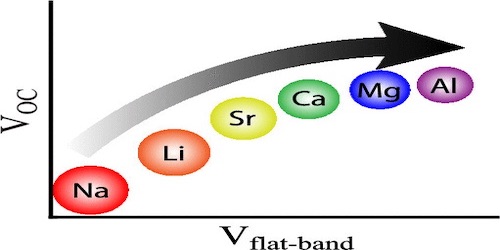
Jake EvansCaudill 008 (919) 843-6852 B.S. Chemistry, minors Computer Science and Physics, 2019 |

|
Contributing Author


The performance of dye-sensitized solar cells (DSSCs) depends on the properties and interactions of three fundamental components: the semiconductor, chromophore, and electrolyte. For the electrolyte, the dependence of DSSC performance on the identity and valence state of the spectator cation has not been well studied in p-type semiconductor systems, although the effects of these species in n-type TiO2 devices are significant, producing large shifts in semiconductor flat-band potential, charge-transfer kinetics, photocurrent, and open-circuit voltage (VOC). Here, we vary the spectator cation in p-type NiO DSSCs and demonstrate an increase in VOC by over 50% with two common redox couples. Using optimal cations, we achieved high VOC values without a significant reduction in photocurrent. Mott–Schottky analysis and electrochemical impedance spectroscopy reveal that the cation can shift the flat-band potential of NiO by nearly 1 V and substantially alter the lifetime of charge carriers and charge-transfer resistance at the semiconductor–electrolyte interface. Differences between the anionic and cationic redox couples employed suggest favorable and unfavorable interactions, respectively, with divalent cations at the NiO surface, causing increases and decreases in charge carrier recombination rate constants. Our results highlight the complex interaction between the semiconductor and electrolyte solution and indicate that varying the cation should yield immediate improvements in device metrics for most p-type DSSC systems.